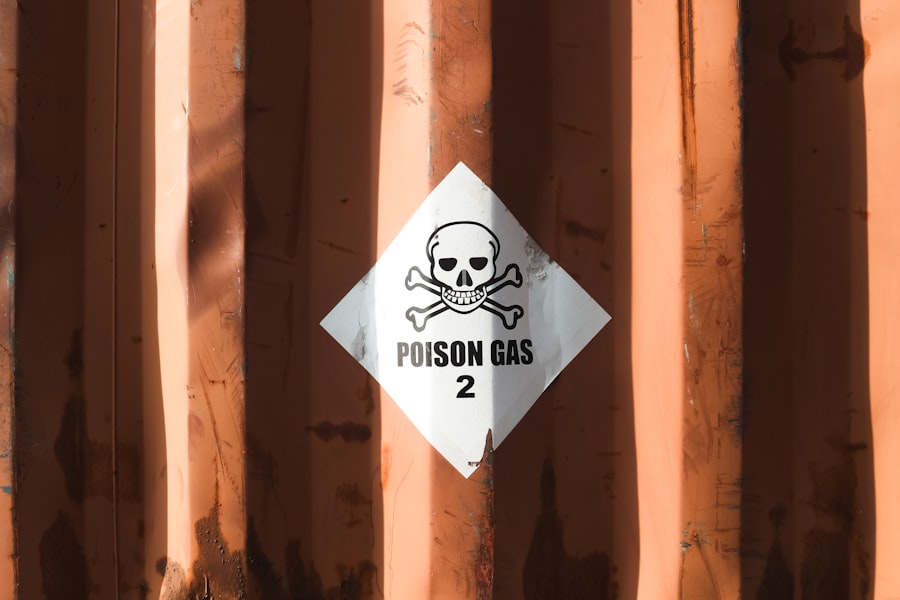GenX chemicals are a group of synthetic compounds that belong to a larger family known as per- and polyfluoroalkyl substances (PFAS). These chemicals were developed as a replacement for older PFAS compounds, particularly perfluorooctanoic acid (PFOA), which has been linked to various health issues. GenX is primarily used in the manufacturing of fluoropolymers, which are materials that provide non-stick and water-repellent properties.
You may encounter these chemicals in everyday products such as cookware, food packaging, and even in some textiles. Their unique properties make them highly effective in repelling water and grease, which is why they have become popular in various industries. You might be surprised to learn that GenX chemicals can also be found in the environment, particularly in water sources.
They have been detected in drinking water supplies, especially near industrial sites where they are produced or used. The persistence of these chemicals in the environment is concerning, as they do not break down easily and can accumulate over time. This accumulation raises questions about their long-term effects on both human health and the ecosystem.
Understanding where GenX chemicals are found is crucial for assessing potential exposure risks and taking appropriate action to mitigate them.
Key Takeaways
- GenX chemicals are synthetic compounds found in industrial products and contaminated water sources.
- Exposure to GenX chemicals is linked to various health risks, including liver and kidney damage.
- Common exposure sources include contaminated drinking water, industrial emissions, and consumer products.
- Regulatory agencies have established guidelines to limit GenX chemical levels and protect public health.
- Public awareness and advocacy efforts are crucial for reducing exposure and promoting stricter regulations.
Health Risks Associated with GenX Chemical Exposure
Exposure to GenX chemicals has been linked to a range of health risks that warrant serious attention. Research indicates that these substances may disrupt hormonal systems, leading to reproductive and developmental issues. You may be particularly concerned if you are pregnant or planning to start a family, as studies suggest that exposure during pregnancy can affect fetal development.
Additionally, there is evidence that GenX chemicals may contribute to immune system dysfunction, making individuals more susceptible to infections and diseases. Another area of concern is the potential link between GenX exposure and certain types of cancer.
If you have been exposed to GenX chemicals, it is essential to stay informed about the latest research findings and consult healthcare professionals regarding any health concerns you may have. The long-term effects of GenX exposure are still being studied, but the existing evidence highlights the need for caution and awareness.
Potential Sources of GenX Chemical Exposure

Identifying potential sources of GenX chemical exposure is vital for protecting yourself and your loved ones. One of the most significant sources is contaminated drinking water, particularly in areas near industrial facilities that produce or use GenX chemicals. If you live near such sites, it is advisable to check local water quality reports and consider using water filtration systems designed to remove PFAS compounds.
You may also want to explore alternative water sources if contamination levels are high. In addition to water sources, you might encounter GenX chemicals in various consumer products. Items such as non-stick cookware, stain-resistant fabrics, and certain food packaging materials can contain these substances.
When purchasing new products, it’s wise to look for labels indicating that they are free from PFAS or GenX chemicals. Being proactive about your choices can significantly reduce your risk of exposure. Furthermore, understanding the potential sources of exposure can empower you to make informed decisions about your health and safety.
Effects of GenX Chemical Exposure on Human Health
| Health Metric | Observed Effect | Exposure Level | Study Duration | Population Studied |
|---|---|---|---|---|
| Liver Function | Elevated liver enzymes indicating liver stress | High (≥10 ppb) | 6 months | Adult volunteers |
| Cholesterol Levels | Increased total cholesterol and LDL cholesterol | Moderate (1-10 ppb) | 1 year | Community residents near contaminated sites |
| Immune Response | Reduced antibody response to vaccines | Low to moderate (0.5-5 ppb) | 2 years | Children aged 6-12 |
| Reproductive Health | Decreased fertility rates and altered hormone levels | High (≥10 ppb) | 1 year | Adult males and females |
| Kidney Function | Increased markers of kidney damage | Moderate (5-10 ppb) | 6 months | Industrial workers |
The effects of GenX chemical exposure on human health are complex and multifaceted. As you delve deeper into this topic, you may find that the impact varies depending on factors such as the level and duration of exposure, individual susceptibility, and existing health conditions. Some individuals may experience acute symptoms like skin irritation or respiratory issues, while others may face more severe long-term health consequences.
The variability in responses underscores the importance of understanding your own health status and potential vulnerabilities. Research has shown that chronic exposure to GenX chemicals can lead to more serious health issues over time. For instance, studies have indicated potential links between these chemicals and liver damage, elevated cholesterol levels, and thyroid dysfunction.
If you have concerns about your health or suspect you may have been exposed to GenX chemicals, it’s crucial to consult with healthcare professionals who can provide guidance tailored to your specific situation. Staying informed about the potential effects of these chemicals can help you take proactive steps toward safeguarding your health.
Precautionary Measures to Minimize GenX Chemical Exposure
Taking precautionary measures to minimize your exposure to GenX chemicals is essential for maintaining your health and well-being. One effective strategy is to be mindful of the products you use in your daily life. Opting for alternatives that are labeled as PFAS-free can significantly reduce your risk of exposure.
For instance, consider using stainless steel or cast iron cookware instead of non-stick options that may contain GenX chemicals. Additionally, when purchasing textiles or cleaning products, look for those that explicitly state they do not contain harmful PFAS compounds. Another important step is to stay informed about local water quality reports.
If you live in an area where GenX contamination has been identified, consider using a water filtration system designed to remove PFAS substances from drinking water. Regularly testing your water supply can also provide peace of mind and help you make informed decisions about your water consumption. By taking these proactive measures, you can significantly reduce your risk of exposure to GenX chemicals and protect your health.
Regulations and Guidelines for GenX Chemicals

Regulations surrounding GenX chemicals are evolving as awareness of their potential risks grows. Various governmental agencies are working to establish guidelines aimed at limiting exposure and protecting public health.
As a concerned citizen, staying informed about these regulations can empower you to advocate for stronger protections in your community. In addition to federal regulations, some states have implemented their own guidelines regarding GenX chemicals. These state-level initiatives often focus on setting limits for acceptable levels of PFAS in drinking water and requiring manufacturers to disclose the presence of these substances in consumer products.
By understanding the regulatory landscape surrounding GenX chemicals, you can better navigate your own exposure risks and support efforts aimed at improving public health standards.
Health Monitoring and Testing for GenX Chemical Exposure
Health monitoring and testing play a crucial role in understanding the impact of GenX chemical exposure on individuals and communities. If you suspect that you have been exposed to these chemicals, consider discussing testing options with your healthcare provider. Blood tests can help determine if PFAS levels are elevated in your system, providing valuable information about your exposure history.
This data can be instrumental in guiding any necessary medical interventions or lifestyle changes. Moreover, community health monitoring initiatives are becoming increasingly important as awareness of GenX chemicals grows. Local health departments may offer testing programs for residents living near contaminated sites, allowing individuals to assess their exposure levels collectively.
Participating in such programs not only benefits your own health but also contributes to broader efforts aimed at understanding the public health implications of GenX chemical exposure.
Environmental Impact of GenX Chemicals
The environmental impact of GenX chemicals extends beyond human health concerns; it also poses significant risks to ecosystems and wildlife. These substances are known for their persistence in the environment, meaning they do not break down easily and can accumulate in soil and water sources over time. As a result, aquatic life may be exposed to harmful levels of GenX chemicals, leading to disruptions in food chains and biodiversity loss.
You may also be interested in how these environmental impacts can affect human communities. Contaminated water sources can lead to restrictions on fishing and recreational activities, impacting local economies and livelihoods. Understanding the broader environmental implications of GenX chemicals can motivate you to advocate for policies aimed at reducing their use and promoting cleaner alternatives.
Occupational Hazards and GenX Chemical Exposure
Occupational hazards associated with GenX chemical exposure are a critical concern for workers in industries where these substances are produced or used. If you work in manufacturing or related fields, it’s essential to be aware of the potential risks associated with handling these chemicals. Employers should implement safety protocols and provide personal protective equipment (PPE) to minimize exposure risks for their employees.
Furthermore, ongoing training and education about the dangers of GenX chemicals can empower workers to take proactive measures in safeguarding their health. If you suspect that your workplace may expose you to these substances, don’t hesitate to voice your concerns with management or seek guidance from occupational health professionals who can provide support tailored to your situation.
Legal and Regulatory Actions Regarding GenX Chemicals
Legal actions surrounding GenX chemicals have gained momentum as communities seek accountability from manufacturers for contamination issues. Lawsuits have been filed against companies responsible for releasing these substances into the environment, aiming to hold them accountable for any harm caused to public health and ecosystems. As a concerned citizen, staying informed about ongoing legal actions can help you understand the broader implications for community safety and environmental protection.
In addition to lawsuits, regulatory actions at both state and federal levels are increasingly focused on addressing the challenges posed by GenX chemicals. Legislative efforts aimed at establishing stricter regulations on their use and disposal reflect growing public concern over their potential risks. Engaging with advocacy groups or participating in community forums can amplify your voice in pushing for meaningful change regarding the regulation of these harmful substances.
Public Awareness and Advocacy for GenX Chemical Exposure
Public awareness plays a vital role in addressing the challenges posed by GenX chemical exposure. As more individuals become informed about the risks associated with these substances, there is greater potential for collective action aimed at promoting change. Advocacy efforts focused on raising awareness about the dangers of GenX chemicals can lead to increased pressure on policymakers to implement stricter regulations and protect public health.
You can contribute to this movement by sharing information with friends, family, and your community about the risks associated with GenX chemicals. Engaging with local advocacy groups or participating in educational events can further amplify your impact. By fostering a culture of awareness around this issue, you not only empower yourself but also encourage others to take action toward creating a safer environment for everyone.
In conclusion, understanding GenX chemicals is crucial for protecting both individual health and environmental integrity. By staying informed about potential sources of exposure, advocating for stronger regulations, and taking proactive measures in your daily life, you can play an active role in minimizing risks associated with these harmful substances. Together, we can work toward a healthier future free from the dangers posed by GenX chemicals.
Recent studies have highlighted the potential health risks associated with GenX chemical exposure, particularly its impact on human health and the environment. For a deeper understanding of these risks and the ongoing research in this area, you can read more in this related article on the topic. Check it out here: GenX Chemical Exposure Risks.
WATCH THIS! The Forever Chemicals: How Your Nonstick Pan Gave You Cancer
FAQs
What is GenX chemical?
GenX is a trade name for a technology used to manufacture fluoropolymers, which are used in various industrial applications. It involves a chemical compound called hexafluoropropylene oxide dimer acid (HFPO-DA), which has been used as a replacement for older perfluorinated chemicals like PFOA.
How are people exposed to GenX chemicals?
People can be exposed to GenX chemicals primarily through contaminated drinking water near manufacturing facilities. Exposure can also occur via air, soil, and food contaminated with GenX compounds.
What are the potential health risks associated with GenX exposure?
Studies suggest that GenX chemicals may cause liver and kidney damage, immune system effects, and developmental issues in animals. However, the full extent of health risks to humans is still being researched.
Is GenX considered safe for use in consumer products?
GenX chemicals are used in the production of certain consumer products, but concerns about their persistence and potential toxicity have led to increased regulatory scrutiny. Some agencies recommend limiting exposure due to potential health risks.
How can GenX contamination be detected?
GenX contamination is typically detected through specialized water testing methods using advanced analytical techniques like liquid chromatography-mass spectrometry (LC-MS).
What regulations exist regarding GenX chemicals?
Regulations vary by country and region. In the United States, the Environmental Protection Agency (EPA) has issued health advisories and is working on setting enforceable limits for GenX in drinking water. Some states have established their own guidelines.
How can individuals reduce their risk of GenX exposure?
To reduce exposure, individuals can use water filtration systems certified to remove PFAS chemicals, avoid consuming contaminated water or food, and stay informed about local water quality reports.
Are there alternatives to GenX chemicals in manufacturing?
Research is ongoing to develop safer alternatives to GenX and other per- and polyfluoroalkyl substances (PFAS) that have similar industrial properties but lower environmental and health risks.
